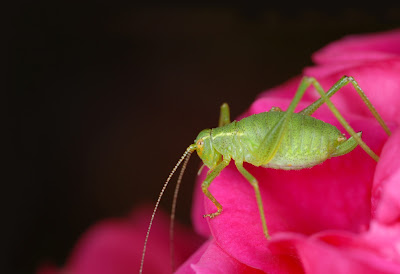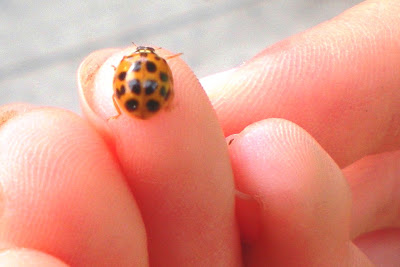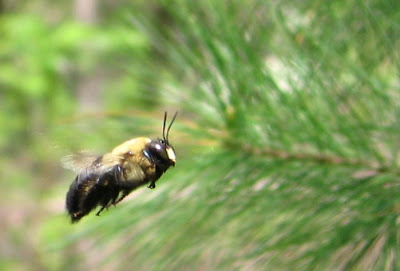Apparently a broadcast bug bulletin went out last week: "Come one, come all ... beetles and bees, wormies and wasps, aphids and mites! There's a new party house in Royal Oak. Open 24 hours!"
I knew this would come--I figured that the time was nigh for my garden to come under attack. The yellowjacket wasp is still sharing space with the carpenter bees, who are busy protecting their little round spaces of homes in my garage eaves (although I've been gently living with them without a sting thus far). The cabbage moths are back and flitting about, and a few cabbage loopers have been found and treated with white flour...these, especially, will be watched carefully in the coming days.
 |
| Lady Beetle larvae |
On the beneficial bug side, I've found Lady Beetle larvae among my brassicas--I've learned that they are a main predator of the aphid and cabbage worm. Hiya! You gals can stay.
Also, from my local farmers' market, I purchased an egg case filled with up to 200 Praying Mantids, which should hatch this month. Praying Mantids have a voracious appetite for all kinds of insects, including aphids, moths, mosquitos, and flies. Come on out, little ones, my garden needs you.

What I was NOT prepared for was
my body to be attacked. Squeamish readers won't like this part ... a week ago today, after a long, hot day of digging deep into the soil bed along my back fence, I started to notice itchy bites on my skin. As time went by back in the house, the bites seemed to multiply. I didn't feel any stings, I didn't see any crawlies, but a few hours after coming indoors, hot welts were developing all over my back, neck, and legs, as well as some under my arms, near my sensitive girlie armpits, and along my bra line. I stopped counting at 130 bites overall. There were more than 30 on one thigh alone, which caused general swelling of the entire area, about the size of my hand. What the ...?!
After a lot of research, I surmised that it was very likely the workings of the chigger mite, a nearly microscopic, round, reddish dude, who moves fast and runs in packs. The chigger is not an insect but an arachnid, related to spiders and scorpions. Let's all say it together now: "Ewww!"
 |
| Microscopic view of a chigger mite |
Chigger mites attach themselves to a host (like, um, ME, for instance) and inject a digestive enzyme that breaks down body tissues. Chiggers then feed on that liquefied tissue. Mmm-mmm. Thankfully, these guys in the United States don't carry any known diseases, and they don't infest homes.
Not so thankfully, they got me, but good. For four to five days, I was a walking itch, inflamed and incensed. The swelling and itching calmed down fairly quickly after that point, even though after a week I still
look like a dirty kid with scabies.
Cortisone spray, vaseline, and ibuprofen helped tremendously those first few days. I also tried clear nail polish and raw honey on the welts, but that really just made me feel stinky and sticky.
What can I say but LESSON LEARNED! I do not need to become one with my soil. There is no need to crawl in it, to practically bathe in it, to get the garden work done. And from now on, I will forget about the capris and sockless garden clogs. When working in the back beds, I need to COVER UP for goshsakes with a long shirt, tall socks, and my knee-high Wellingtons, even in my small yard. And I'll try the Burt's Bees or Skin-so-Soft treatments before going out.
I hate to say it, but the Bug Bash isn't even fully amped up yet, as June Bug, Japanese Beetle, and Mosquito season is still around the corner.
Sources:
"Chiggers!" MDC Online, Missouri Department of Conservation,
http://mdc.mo.gov/discover-nature/avoid-outdoor-pests/chiggers.
"Chiggers - Mites That Bite!" Living with Bugs,
http://www.livingwithbugs.com/chigger.html.
Cranshaw, W.S., "Lady Beetles," Colorado State University Extension,
http://www.ext.colostate.edu/pubs/insect/05594.html.
"Eight Interesting Facts About Aphids and Suggestions for Control," Karen's Garden Tips,
http://www.karensgardentips.com/growing-garden-plants/garden-pests-diseases/eight-interesting-facts-about-aphids-and-suggestions-for-control/.
Hamir, Arzeena, "Using the Praying Mantis in Your Garden,"
http://www.gardenguides.com/840-using-praying-mantis-garden-garden-pest-tip.html.
Smith, Jennifer, "Chiggers: Fact and Fiction," LJWorld.com,
http://www2.ljworld.com/news/2008/aug/21/chiggers_fact_and_fiction/.






















































.JPG)